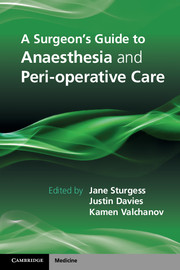Book contents
- Frontmatter
- Contents
- List of contributors
- Foreword
- Section I Basic sciences
- Chapter 1 General physiology
- Chapter 2 System-specific physiology
- Chapter 3 Pain and analgesia
- Chapter 4 Local anaesthetics
- Chapter 5 Sedation
- Chapter 6 Physics and measurement
- Section II Anaesthesia and peri-operative care for surgical specialties
- Section III At a glance
- List of abbreviations
- Index
- References
Chapter 5 - Sedation
Published online by Cambridge University Press: 05 July 2014
- Frontmatter
- Contents
- List of contributors
- Foreword
- Section I Basic sciences
- Chapter 1 General physiology
- Chapter 2 System-specific physiology
- Chapter 3 Pain and analgesia
- Chapter 4 Local anaesthetics
- Chapter 5 Sedation
- Chapter 6 Physics and measurement
- Section II Anaesthesia and peri-operative care for surgical specialties
- Section III At a glance
- List of abbreviations
- Index
- References
Summary
Definition
Sedation is the term used to describe a continuum of a drug-induced state from normal alert consciousness to complete unresponsiveness. Surgeons may be exposed to sedated patients in the operating theatre, on the ward, in the emergency department and in the endoscopy suite (where procedures include upper and lower GI tract endoscopy, bronchoscopy and cystoscopy). In addition, there may not be an anaesthetist present when a patient under the care of a surgical team is sedated. Therefore, an understanding of this topic is essential to minimise risk and maintain patient safety.
Levels of sedation have been defined by the American Society of Anesthesiologists (ASA), and are often referred to as levels 1 to 4:
Minimal sedation (or anxiolysis). This is a drug-induced state during which patients respond normally to verbal commands. Cognitive function and co-ordination may be impaired, but cardiovascular and respiratory function will be unaffected.
Moderate sedation/analgesia (or ‘conscious sedation’). This is a drug-induced state that results in reduced consciousness. Patients will respond to verbal commands and no interventions are required to maintain a patent airway. Cardiovascular function is usually maintained.
Deep sedation/analgesia. This is a drug-induced depression of consciousness during which time patients cannot be easily roused but do respond purposefully following repeated or painful stimulation. There may be impairment of independent ability to maintain ventilation and patients may need assistance in maintenance of a patent airway with spontaneous ventilation being potentially inadequate. Cardiovascular function is maintained.
General Anaesthesia. This is a drug-induced loss of consciousness. Patients are not rousable, even with painful stimulation. Patients will generally require assistance maintaining patent airway and positive-pressure ventilation may be required. Cardiovascular function may be impaired. General anaesthesia also requires amnesia, unlike the previous three levels where it is optional. Additionally general anaesthesia concerns itself with analgesia too.
- Type
- Chapter
- Information
- A Surgeon's Guide to Anaesthesia and Peri-operative Care , pp. 59 - 62Publisher: Cambridge University PressPrint publication year: 2014

